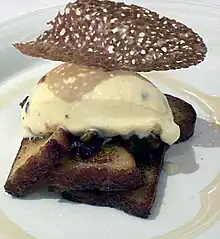Tuile
A tuile (/twiːl/) is a baked wafer, French in origin, generally arced in shape, that is made most often from dough (but also possibly from cheese), often served as an accompaniment of other dishes.[1] Tuile is the French word for tile, after the shape of roof tiles that the arced baked good most often resembles.[2] Tuiles are commonly added as garnishes to desserts such as panna cotta or used as edible cups for sorbet or ice cream.[3]
.jpg.webp) A tuile arced over a creme caramel dessert | |
| Type | Cookie or wafer |
|---|---|
| Place of origin | France |
| Main ingredients | Flour, white sugar, butter, and almonds |
Preparation
Tuiles are thin cookies named for and curved like the tuiles, or tiles, that line the rooftops of French country homes, particularly those in Provence.[4] To get a curved shape, tuiles are usually made on a curved surface, such as a wine bottle or rolling pin.[5] In France, tuile molds are also sold. Tuiles must be curved while hot; otherwise, they will crack and break.[6] Tuiles can also be left flat after baking. The traditional tuile batter consists of flour, white sugar, melted butter, and almonds. Modern variants include a wide variety of bases and flavours (see gallery).
Gallery
.jpg.webp) A simple bread tuile served with foie gras.
A simple bread tuile served with foie gras. A cinnamon tuile over French toast and bacon ice cream.
A cinnamon tuile over French toast and bacon ice cream. A honey tuile over cups containing a sweetened cream, ginger panna cotta.
A honey tuile over cups containing a sweetened cream, ginger panna cotta.
See also
References
- Biró, Marcel, and Shannon Kring. Biró: European-Inspired Cuisine. Gibbs Smith, 2005. 114. Print.
- Boulud, Daniel, and Dorie Greenspan. Daniel Boulud's Café Boulud cookbook: French-American recipes for the home cook. Scribner, 1999. 165. Print.
- W., Carol, Erik Tieze, and Glenn Humphry. Creating Chefs: A Journey Through Culinary School with Recipes and Lessons. Lyons Press, 2005. 228. Print.
- Greenspan, Dorie, and Alan Richardson. Baking: From My Home to Yours. Houghton Mifflin Harcourt, 2006. 173. Print.
- McCarty, Michael, Judith Choate, Liz Smith, and Steve Pool. Welcome to Michael's: Great Food, Great People, Great Party!. Little Brown & Co, 2007. Print.
- Luchetti, Emily, and Sheri Giblin. Classic Stars Desserts: Favorite Recipes by Emily Luchetti. Chronicle Books Llc, 2007. 129. Print.